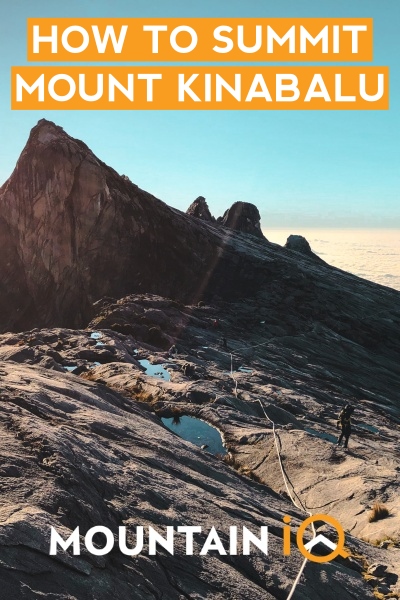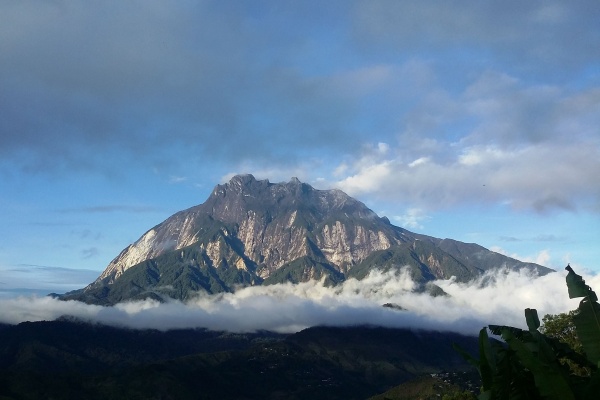Sitting at 4,095m above sea level, majestic Mount Kinabalu is the highest mountain in Southeast Asia. One of the youngest non-volcanic mountains in the world, hiking Mount Kinabalu is a breath-taking experience. It’s a popular bucket list destination for most mountain enthusiasts!
The Kinabalu National Park is home to this majestic mountain and has been declared a UNESCO World Heritage Site for its rich biodiversity and wide range of habitats.
We’ve put together a complete guide with all you need to know for planning a trek to the summit of Mount Kinabalu.
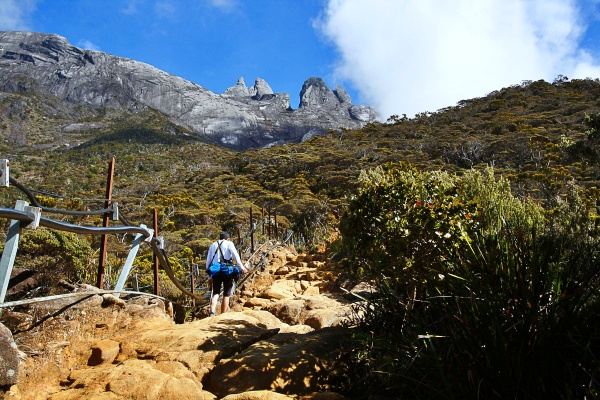
Mount Kinabalu Trek (11 FAQs)
When is the best time to Hike Mount Kinabalu?
Mount Kinabalu can be summited throughout the year, however, this is weather permitting. In the event that the weather is deemed too dangerous to hike then Sabah Parks Authority will close the gate to the summit for obvious safety reasons.
March to September is the peak hiking period for Mount Kinabalu, however we recommend March and April for the best weather to summit Mount Kinabalu. You’ll have clearer skies for epic photo opportunities.
June and September are still good months to hike, but the temperature can be extremely hot during this time.
What routes can you take to the summit of Kinabalu?
There are two routes to the summit of Mount Kinabalu, both of which take two days to complete. For safety reasons, Sabah Park has suspended one day climbs.
The popular Ranau Trail and the less travelled Kota Belud Trail are the two main routes to the summit. Each being a completely unique trekking experience.
Both trails begin from Timpohon Gate where you’ll trek 6 kms to Panalaban Basecamp. Panalaban sits 3,272m above sea level. Here, you’ll spend one night in their mountain huts before an early rise to head on your separate routes to the summit. The trails meet again at Sayat-Sayat Checkpoint where you’ll begin your ascent to Low Peak summit.
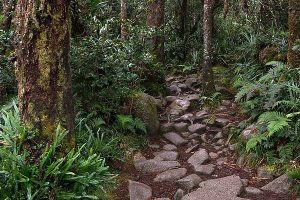
1. The Ranau Trail
This is the standard route to hike Mount Kinabalu. Majority of the trail is made up of stairs either wooden or carved from the rocks. Ropes have been installed in certain areas to assist with climbing the stairs and steeper sections. Nearer the end of the trail you’ll hike up granite surface terrain to the summit.
This is a well maintained and popular trail that is easy for average climbers and can be done by almost anyone. There is a viewing platform at Aki Point from where you can see stunning panoramic views of the surrounding forests and the ‘zigzag’ staircase trail (The Kota Belud Trail).
A highlight on this trail is the Aki Point Viewing Platform built over the edge of a rockface. It offers hikers epic panoramic views of the surrounding forests and the town of Ranau. You will even be able to see the zig zag staircase trail (Kota Belud) on a clear day! The platform is close to the Via Farrata starting point.
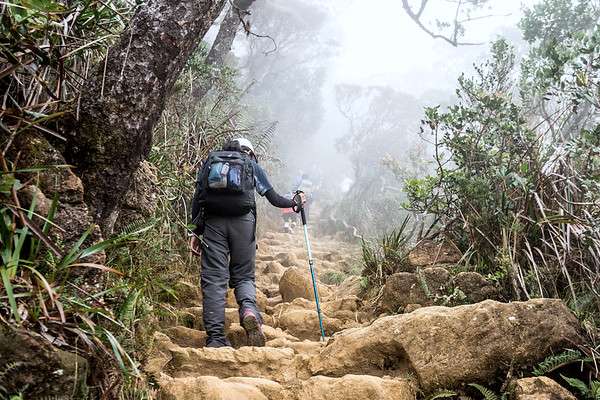
2. The Kota Belud Trail
A challenging alternative route to the summit of Mount Kinabalu, the Kota Belud Trail is steep, made up of many wooden stairs and uses ropes to lead the way and assist hikers on their trek to the top.
The final part of this trail is the most challenging as you’ll be trekking on an incline of 60 degrees using ropes to make it through. From this trail you’ll see panoramic views of Panalaban Basecamp and Mount Trus Madi. The trail will also take you past the ruins of Panar Laban Hut and Gunting Lagadan Hut.
Important Points:
- Special permission is required for this trek
- Only 30 people are allowed to use this route per day
- There needs to be one mountain guide per three climbers on this route
- Hikers must be 18 years old or older to gain access
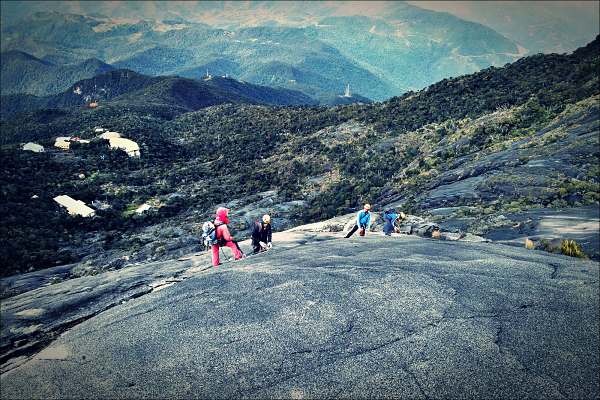
Is there a Via Ferrata option on Mount Kinabalu?
Climbing via ferrata means that you will be climbing the mountain on a protected route made up of a series of ropes, rails, cables and bridges which are secured to the rock-face.
The ferrata activity on Mount Kinabalu is an optional but exhilarating experience. This is the highest via ferrata route in the world! If you have opted to do the ferrata activity, you'll begin after returning to Panalaban. Accommodation for via ferrate climbers is at the Pendant Hut.
There are two Via Ferrata options on Mount Kinabalu - Walk the Torq and Lows Peak Circuit. The latter being for the more experienced climber.
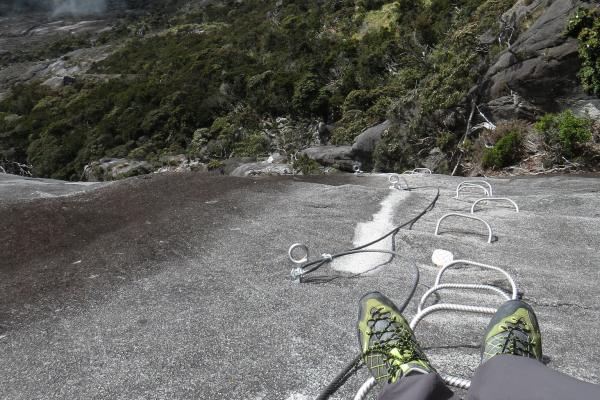
Walk the Torq
- Height: 3,521m
- Duration: 2 to 3 hours (Beginners) / 4 to 5 hours (Intermediate)
- Difficulty: Beginner / Intermediate climbers (little or no rock climbing experience is required)
- Age & Height Requirements: Over 10 years old & 1.3m tall
- Number of Climbers Allowed: 6
Beginners will take the route that scales along the granite walls of Mount Kinabalu. It is designed for beginners and you'll be securely fastened to the wall. Intermediate climbers will take a more challenging route which takes you to hidden areas ont he mountain and offers breathtaking views. The trail consists of ladders, bridges and ropes.
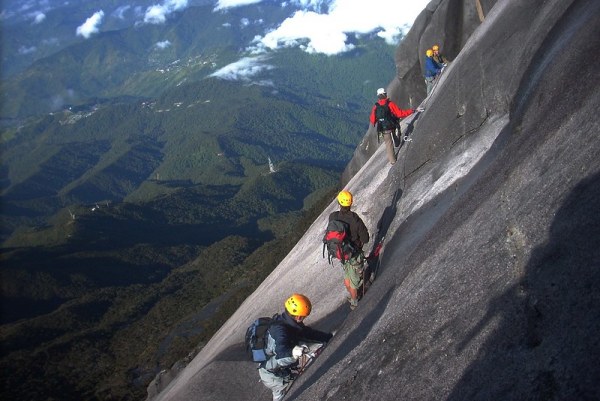
Photo by Travelmate Holidays
Lows Peak Circuit
- Height: 3,776m
- Duration: 4 to 6 hours
- Difficulty: Above average fitness level required
- Age & Height Requirements: Over 17 years old & 1.3m tall
- Number of Climbers Allowed: 6
The Low's Peak Circuit has been declared by Guinness World Records as the highest via ferrata in the world. This route was designed for the brave! You'll explore hidden corners of the mountain, shuffle along on of the highest suspension bridges in the world sitting at 3,600m, and cross the Nepalese bridge at 3,580m. The trail connects with the 'Walk the Torq' trail which takes you to the summit of Mount Kinabulu, giving you the best of both worlds!
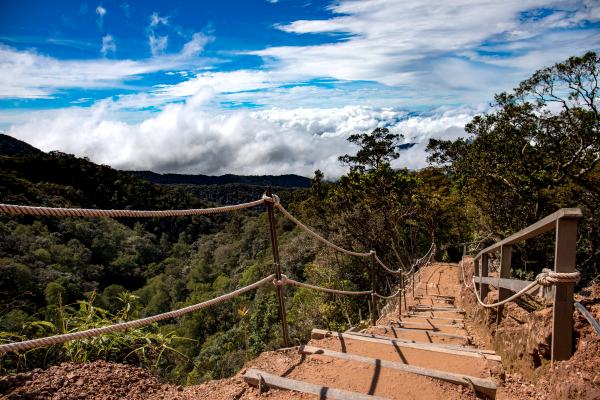
Photo by Mahosadha Ong
How difficult is hiking Mount Kinabalu?
Summiting Mount Kinabalu can be done by non-technical hikers and is considered one of the best hikes in Asia. If you are in good health and can deal with lots of steps and steep inclines, then you will be able to handle the journey to the summit of Mount Kinabalu.
Children as young as 3 years old have been seen on the Ranau Trail, however I recommend children only hike to the summit if they are over 10 years old and can handle the steep slopes and the amount of stairs.
What do I need to pack for Hiking Kinabalu?
Below are our recommendations for clothing, gear and essentials you'll need to hike Mount Kinabalu.
Clothing
- Hiking/Alpine Boots
- Waterproof Jacket
- Waterproof Gloves
- Hiking Socks
- Lightweight Hiking Pants
- Fleece Top
- Base Layer Top
- Trekking Shirts
- Sun Hat / Beanie
Gear
- Small Backpack
- Headlamp
- Water Bottle
- Earplugs
- Sunglasses
- Trekking Poles
- Sleeping Bag
- Sleeping Pad
Essentials
- Small First Aid Kit
- Snacks
- Blister Cream
- Insect Repellent
- Money
- Sunscreen
- Toilet Paper
- Camera
- Dry Bags
- Water Purifying Tablets / Water Filter Bottle
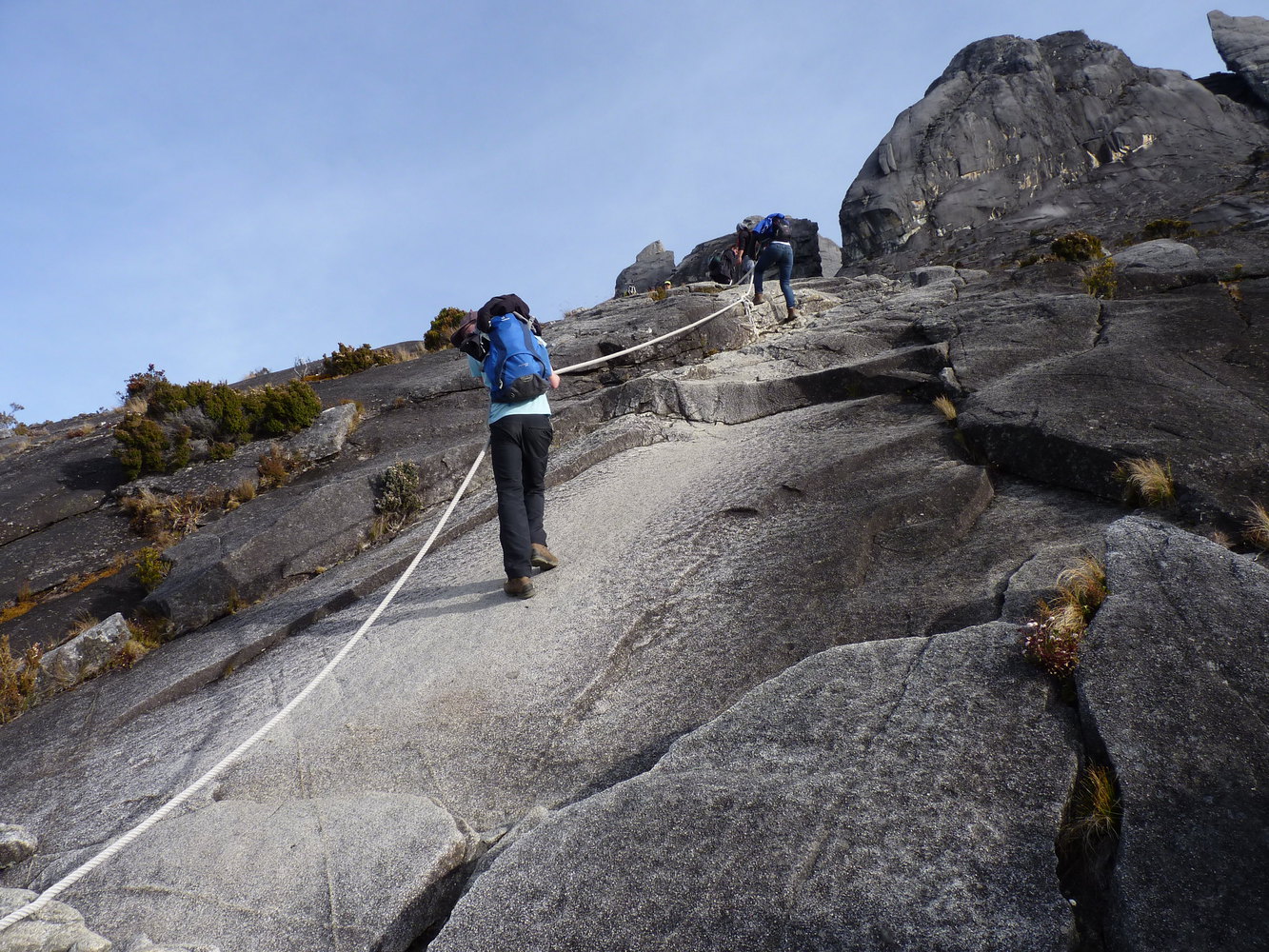
How should you prepare for the Mount Kinabalu Trek?
You do not need to be a professional mountaineer to summit Mount Kinabalu but you will need to have a good fitness level to cope with the many, many steps and the steep inclines.
Getting in some prior training is a good idea so that you can enjoy the hike that much more. Go for walks and hikes on different terrains, preferably with inclines and stairs. The trails can be straining on your knees and ankles so working on your joint strength is important to withstand the hike.
I highly recommend staying in the Kinabalu National Park area for at least one night prior to your hike. This will help your body acclimatize to the high altitude and prepare you for the summit.
Can you hike Kinabalu independently?
All hikers attempting to summit Mount Kinabalu are required to hire a mountain guide.
The Ranau Trail has a limit of one mountain guide per five hikers, and the Kota Belud Trail requires one mountain guide per three hikers.
You do not have to book a package through a tour company, but you will need to ensure you have covered all your bases and paid well in advance for you permit, accommodation etc.
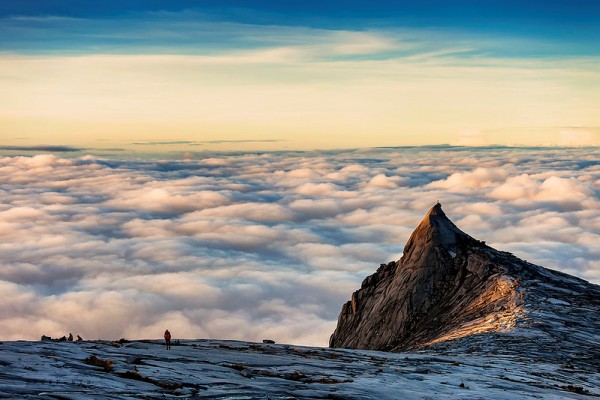
Is a permit required to hike Mount Kinabalu?
Hiking Mount Kinabalu is a very popular activity and requires a permit. Permits are limited to 135 hikers per day. Due to the popularity and limited number of permits, we recommend booking with Sabah Parks at least 6 months in advance. Accommodation must be booked to get your permit.
Special permission is required from Sabah Parks management for those who wish to take the Kota Belud Trail. There are only 30 permits available per day for hikers on this trail.
Important Note: Please ensure that you have your permit and ID tag on you at all times while hiking Mount Kinabalu. These items are essential for you to gain access to the summit.
How do you get to the Mount Kinabalu trailhead?
The starting and ending point for all hikers heading to the Mount Kinabalu trailhead is at Timpohon Gate (1,866m) in Kinabalu National Park.
For hikers who intend to reach the summit you will need to check into the Park Headquarters by 9am. From Kota Kinabalu, it will take you around 2 hours to reach the park.
It is a good idea to consider booking accommodation at one of the guest houses near to the base of the mountain near the park. Stay overnight and acclimatize before heading up the mountain the next day.
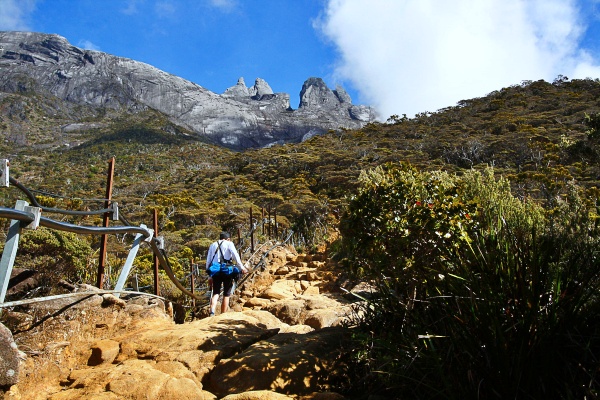
What costs do you need to consider for Hiking Mount Kinabalu?
Mount Kinabalu hikes are known to be pricey, but it truly is worth it for this amazing experience. These fees are all arranged by the Sabah Parks office and you will have to pay upfront.
Hiking Fees (compulsory and optional) | Prices |
|---|---|
Packages | RM 1,500 - RM2,600 |
Permits | RM 200 (International hikers) |
Mountain Guide (1 guide per 5 hikers) | RM 230 |
Climbing Insurance (compulsory) | RM 7 |
Accommodation (Laban Rata) Accommodation (Pendant Hut) | RM 1200 per person per night RM 800 per person per night |
Shuttle Bus | RM 35 |
Souvenir Certificate | RM 10 |
Hiking Pole Rental | RM 15 |
Porter | RM 160 per 10kg |
Stored Luggage | RM 12 |
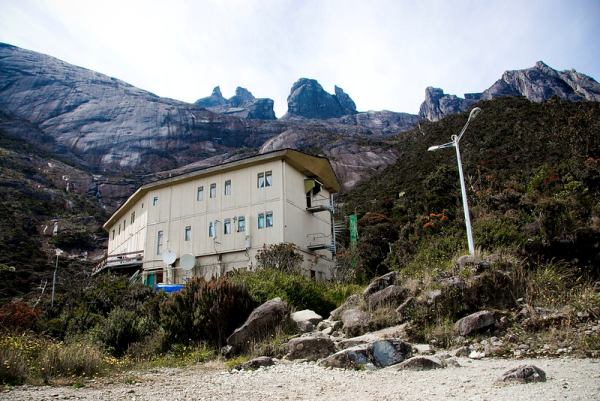
Laban Rata Hut photo by Jason Jones
What accommodation will you stay in?
Via ferrata climbers will stay in the Pendant Hut, which is separate from the standard hikers' accommodation at Laban Rata Hut. Laban Rata accommodates 77 people in mixed dormitory rooms.
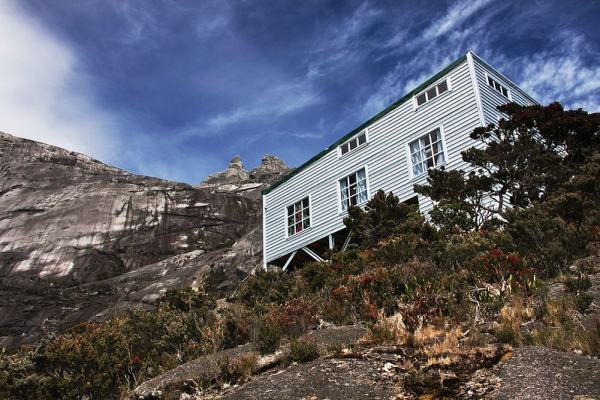
Pendant Hut photo by Travelmate Holidays
Continue browsing
See more information on Asia. Or check out these other Asian Hiking articles:
